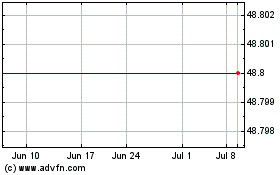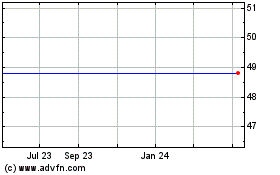Investors shed shares, worrying that sector is too pricey after
year's sharp runup
By Ben Eisen
This year's hot dividend stocks are feeling the autumn
chill.
Utilities shares fell for a ninth-straight day on Wednesday,
marking their longest losing streak since 2002. The latest moves
deepen the recent slide in income-producing investments and
underscore the sharp reversals in popular sectors as investors
warily watch central banks.
The S&P Utilities sector dropped 7.5% in the last nine
trading days, including a 0.3% fall Wednesday, cutting its
year-to-date gain to 8.9%. AES Corp. slid 10% during the last nine
trading days, while Exelon Corp. declined 8.8%. Utilities aren't
the only victim: Real-estate shares, which like utilities are
valued for their rising dividend payouts, dropped 6.7% in the nine
days through Wednesday.
The utilities and real-estate sectors are the worst-performing
groupings in the S&P 500 for the first three trading days of
the fourth quarter, down 3.7% and 5.2%, respectively, compared with
a 0.4% fall in the broader index.
The pullback comes as some fund managers have been selling
richly valued stocks and increasing cash holdings, concerned that a
roaring rally in such stocks earlier this year had made many too
pricey.
Valuations among global high-yielding stocks were at their
highest levels in more than a decade in June, according to
BlackRock Inc.
"Trees don't grow to the sky," said Brad Neuman, client
investment strategist at Fred Alger Management Inc. "It was almost
like the market was waiting for an excuse" to send high-yielding
stocks back toward their historical valuations, he added,
suggesting that such stocks could keep falling back toward those
levels.
At the same time, the recent selling in utilities and
real-estate investment trusts has been matched and at times
exceeded by declines in gold and silver, investments that offer
holders no income. Declines in safe stocks and speculative metals
together highlight how sensitive markets have become to modest
shifts in sentiment, particularly on expectations for central-bank
stimulus plans.
Nick Clay, who manages the Dreyfus Global Equity Income Fund,
said he had to sell some of his stock holdings this year because
their valuations reached levels at which the fund's guidelines
dictate they can no longer be held. His portfolio owns 49 stocks,
making it the most concentrated since inception.
Among the holdings his fund has sold this year is Clorox Co.,
regulatory filings show. The company on Wednesday closed at 24.71
times its earnings over the past 12 months, according to
FactSet.
The price-to-earnings ratios of high-dividend sectors have been
rising this year. Even after the recent decline in share prices,
Utilities had a 12-month trailing price-to-earnings ratio of 21.4
as of Tuesday, versus 19.8 for the S&P, according to FactSet.
At the beginning of the year, utilities had a lower ratio than the
broader market.
The selloff of recent days extends a pullback that began in the
third quarter. Utilities slid 6.7% in the June-to-September period,
the sector's worst quarterly percentage decline since the beginning
of 2009. Real estate, which was split into its own sector last
month, fell 2.9%.
It has become particularly difficult to find income in the bond
market this year, with yields on the benchmark 10-year Treasury
note hitting record lows in July. Yields fell even further in
Europe and Japan, where central banks have been experimenting with
negative-rate policies.
At the same time, many investors are becoming choosier about how
they invest in stocks after years of gains have heightened fears of
a large selloff.
That fear this year drove interest in dividend-bearing stocks,
which offer bondlike income that helps to balance the volatility of
stock prices, while still offering the potential for capital
appreciation. Broad swaths of investors piled into utilities and
other high-dividend sectors.
"You can get people performance-chasing," said Bob Landry, a
portfolio manager who looks after the dividend-stock strategy for
separately managed accounts at USAA Investments. "If they're
performance-chasing, they're in the market for the wrong
reason."
Mr. Landry said his accounts now have about 6% in cash, above
the norm of 1% to 3% he ideally keeps. He said he wants to be able
to pounce on cheaper stocks, after taking some profits by trimming
holdings such as Merck & Co. and Bemis Co.
He isn't ready yet, however; Mr. Landry said he was still
concerned about rich valuations, and would like to see a deeper
pullback before adding to his holdings, particularly in sectors
such as utilities and real estate.
Recently, investors have been pulling money from the Utilities
Select Sector SPDR Fund, a $7.3 billion exchange-traded fund that
tracks utility shares.
Withdrawals totaled $920.4 million in the third quarter, though
the fund has still taken in more than $925 million in new money
this year, according to Morningstar.
Still, rising share prices are sure to make 2016 a year to
remember for dividend investors, with returns at many
dividend-focused funds still on pace to surpass those of the
broader market.
Many investors say opportunities still abound among
high-dividend stocks, especially in sectors of the market that
aren't usually associated with dividends.
"The valuations for health care are very attractive,
particularly for pharmaceutical companies which have really juicy
yields," said Diane Jaffee, a senior portfolio manager at TCW
Group.
In particular, she said her firm has been adding to holdings of
Gilead Sciences Inc., noting its price has been hit by political
controversy over drug pricing ahead of the U.S. presidential
elections.
The stock had a price-to-earnings ratio of 6.83 on
Wednesday.
Still, she said her portfolios now have the lowest allowable
weighting on traditional high-dividend sectors such as utilities,
telecommunications and real-estate investment trusts.
Write to Ben Eisen at ben.eisen@wsj.com
(END) Dow Jones Newswires
October 06, 2016 02:47 ET (06:47 GMT)
Copyright (c) 2016 Dow Jones & Company, Inc.
Exelon (NYSE:EXC)
Historical Stock Chart
From Mar 2024 to Apr 2024

Exelon (NYSE:EXC)
Historical Stock Chart
From Apr 2023 to Apr 2024
